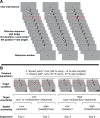Phasic and sustained interactions of multisensory interplay and temporal expectation
- PMID: 29976998
- PMCID: PMC6033875
- DOI: 10.1038/s41598-018-28495-7
Phasic and sustained interactions of multisensory interplay and temporal expectation
Abstract
Every moment organisms are confronted with complex streams of information which they use to generate a reliable mental model of the world. There is converging evidence for several optimization mechanisms instrumental in integrating (or segregating) incoming information; among them are multisensory interplay (MSI) and temporal expectation (TE). Both mechanisms can account for enhanced perceptual sensitivity and are well studied in isolation; how these two mechanisms interact is currently less well-known. Here, we tested in a series of four psychophysical experiments for TE effects in uni- and multisensory contexts with different levels of modality-related and spatial uncertainty. We found that TE enhanced perceptual sensitivity for the multisensory relative to the best unisensory condition (i.e. multisensory facilitation according to the max-criterion). In the latter TE effects even vanished if stimulus-related spatial uncertainty was increased. Accordingly, computational modelling indicated that TE, modality-related and spatial uncertainty predict multisensory facilitation. Finally, the analysis of stimulus history revealed that matching expectation at trial n-1 selectively improves multisensory performance irrespective of stimulus-related uncertainty. Together, our results indicate that benefits of multisensory stimulation are enhanced by TE especially in noisy environments, which allows for more robust information extraction to boost performance on both short and sustained time ranges.
Conflict of interest statement
The authors declare no competing interests.
Figures


Similar articles
-
The role of multisensory interplay in enabling temporal expectations.Cognition. 2018 Jan;170:130-146. doi: 10.1016/j.cognition.2017.09.015. Epub 2017 Oct 9. Cognition. 2018. PMID: 28992555
-
Cross-modal perceptual enhancement of unisensory targets is uni-directional and does not affect temporal expectations.Vision Res. 2022 Jan;190:107962. doi: 10.1016/j.visres.2021.107962. Epub 2021 Oct 29. Vision Res. 2022. PMID: 34757275
-
Implicit expectation modulates multisensory perception.Atten Percept Psychophys. 2022 Apr;84(3):915-925. doi: 10.3758/s13414-022-02460-z. Epub 2022 Mar 1. Atten Percept Psychophys. 2022. PMID: 35233744 Free PMC article.
-
The Intricate Interplay of Spatial Attention and Expectation: a Multisensory Perspective.Multisens Res. 2020 Mar 17;33(4-5):383-416. doi: 10.1163/22134808-20201482. Multisens Res. 2020. PMID: 31940592 Review.
-
The efficacy of single-trial multisensory memories.Multisens Res. 2013;26(5):483-502. doi: 10.1163/22134808-00002426. Multisens Res. 2013. PMID: 24649531 Review.
Cited by
-
Minimal interplay between explicit knowledge, dynamics of learning and temporal expectations in different, complex uni- and multisensory contexts.Atten Percept Psychophys. 2021 Aug;83(6):2551-2573. doi: 10.3758/s13414-021-02313-1. Epub 2021 May 11. Atten Percept Psychophys. 2021. PMID: 33977407 Free PMC article.
-
Context dependency of time-based event-related expectations for different modalities.Psychol Res. 2022 Jun;86(4):1239-1251. doi: 10.1007/s00426-021-01564-9. Epub 2021 Jul 28. Psychol Res. 2022. PMID: 34319439 Free PMC article.
References
Publication types
MeSH terms
Grants and funding
- SFB-TR31-TPA08/Deutsche Forschungsgemeinschaft (German Research Foundation)/International
- SFB-TR31-TPA08/Deutsche Forschungsgemeinschaft (German Research Foundation)/International
- SFB-TR31-TPA08/Deutsche Forschungsgemeinschaft (German Research Foundation)/International
- SFB-TR31-TPA08/Deutsche Forschungsgemeinschaft (German Research Foundation)/International
LinkOut - more resources
Full Text Sources
Other Literature Sources
Molecular Biology Databases

